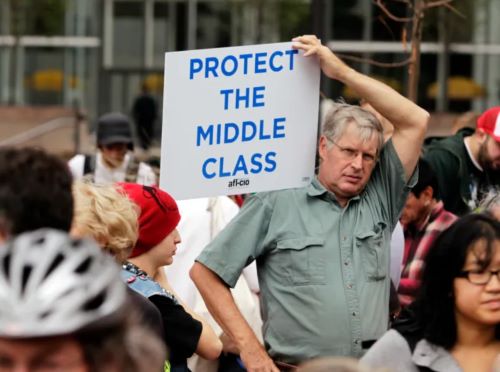

The middle class is bearing more of the cost and receiving less of the reward. And the one chance they had for a recalibration this year was turned aside without fanfare.

By Matthew A. McIntosh
Public Historian
Brewminate
A Moment of Economic Fracture
The language of the middle class has always occupied a strange place in American politics. It is invoked often, praised loudly, and protected in theory. But for all its rhetorical use, the actual economic policies aimed at helping the middle tier of society often fall flat. In 2025, the disparity between promise and practice became especially stark when President Donald Trump, now in his second term, declined to support a proposed tax cut specifically aimed at middle-income households.
The proposal, modest in scale but symbolically loaded, had gathered momentum in both conservative and moderate circles. It would have reduced the income tax burden on households earning between $50,000 and $150,000 annually — a group that has seen its real wages stagnate, its savings shrink, and its purchasing power erode over the past two decades. The plan was designed to be revenue-neutral by slightly raising capital gains rates for ultra-high earners and closing certain offshore loopholes.
It was, in effect, a balancing act. The middle class would get a lift, and the wealthiest Americans would bear a small, strategic recalibration. But Trump said no.
A Calculated Rejection
The official explanation from the White House was vague. Spokespeople pointed to the “need for broad-based tax simplification” and emphasized that any future tax relief must be “pro-growth and pro-investment.” In practice, this language has long been code for tax policy tilted toward corporations and the top percentile.
Behind closed doors, the rationale was clearer. According to multiple aides speaking anonymously, Trump viewed the proposal as politically unnecessary and economically uninteresting. His base, they argued, was more animated by culture war issues than fiscal fairness. And Wall Street donors had already voiced concerns about any increases to capital taxes, no matter how modest.
The rejection was not just about policy. It was about alignment. Trump’s economic instincts, shaped by decades of business dealings and a worldview centered on accumulation, continue to favor the investor class over the working family.
The Shrinking Middle

This refusal comes at a time when the American middle class is showing signs of real strain. According to a 2024 Pew Research Center report, the share of U.S. adults living in middle-income households has declined from 61 percent in 1971 to just 50 percent today.
Wages have not kept pace with inflation. Housing costs have surged in nearly every metropolitan area. Childcare expenses are often equal to or greater than a second mortgage. Health insurance deductibles are higher, even as coverage narrows.
The pandemic and its aftermath further destabilized household budgets. Emergency savings were drained. Debt ballooned. And while the stock market soared through much of 2024, the benefits of that growth were highly concentrated.
For many families, the idea of upward mobility has become more nostalgic than real. The middle class is still the American ideal. But it is no longer the American experience for millions.
A History of Uneven Relief
This is not the first time Trump has passed on delivering meaningful tax relief to middle-income earners. In 2017, the Tax Cuts and Jobs Act, his signature legislative achievement, offered modest short-term savings to average households but delivered far more substantial and permanent benefits to corporations and the top 1 percent.
While Trump claimed the bill would pay for itself through growth, deficit projections tell another story. The national debt swelled. Corporate stock buybacks increased. Wealth inequality deepened.
And now, in his second term, rather than correcting that imbalance, Trump appears committed to preserving it. By declining to support a targeted tax cut for the middle class, especially one that could have been framed as bipartisan and economically stabilizing, he reaffirmed the priorities that have defined his approach from the beginning.
The Politics of Distraction
It is also worth noting what issues Trump has chosen to amplify instead. In recent months, he has focused his attention on immigration crackdowns, educational content bans, and an escalating war of words with major news outlets. These themes dominate his rallies and social media posts.
Tax policy, though still mentioned in broad strokes, rarely surfaces in specific terms. When it does, it tends to revolve around the promise of more deregulation, more cuts for investors, and more rhetorical praise for the “job creators.”
The middle class, meanwhile, is left in a familiar place: celebrated in theory, sidelined in practice.
What Could Have Been
The rejected proposal had the potential to put an average of $1,500 back into the hands of middle-income families each year. For many, that money would have gone toward groceries, gas, school supplies, or savings.
By declining to support it, Trump did more than block a tax cut. He sent a message about whose needs matter most in his vision of the economy.
The cost of that message will not be evenly distributed.
A Turning Point or a Missed Opportunity?
As 2026 looms, the long-term consequences of this decision are difficult to fully chart. It may fade into the background amid more sensational headlines. Or it may become a turning point — a moment when middle-class voters begin to realize that the slogans of populism are not always backed by substance.
For now, the numbers speak for themselves. The middle class is bearing more of the cost and receiving less of the reward. And the one chance they had for a recalibration this year was turned aside without fanfare.
No grand press conference. No detailed rebuttal. Just a quiet, familiar no. And behind that silence, a country still trying to understand who, exactly, the economy is working for.
Originally published by Brewminate, 07.24.2025, under the terms of a Creative Commons Attribution-NonCommercial-NoDerivatives 4.0 International license.


